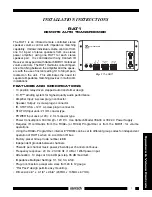
Section 2 – Radio Controlled Safety (Continued)
3
2-4.
Persons Authorized To Operate Radio Controlled Cranes.
Only properly trained persons designated by management should be permitted to operate radio-controlled cranes.
Radio controlled cranes should not be operated by any person who cannot read or understand signs, notices and
operating instructions that pertain to the crane.
Radio controlled cranes should not be operated by any person with insufficient eyesight or hearing or by any person
who may be suffering from a disorder or illness or is taking any medication that may cause loss of crane control.
2-5.
Training Checklist for Crane Operators.
Anyone being trained to operate a radio-controlled crane should possess as a minimum the following knowledge and
skills before operating the crane:
The operator should have knowledge of hazards peculiar to crane operation.
The operator should have knowledge of the safety rules for radio-controlled cranes.
The operator should have the ability to judge distance or moving objects.
The operator should have knowledge of the radio transmitter.
The operator should know the limit switch test procedure.
The operator should know, where authorized, instructions for plugging motions.
The operator should have knowledge of the use of crane warning lights and alarms.
The operator should have knowledge of observing crane signal lights.
The operator should be trained to avoid striking any obstructions.
The operator should have knowledge of the proper clearance of lifts or hooks before moving bridge or trolley.
The operator should have knowledge of the proper storage space for radio control box when not in use.
The operator should be trained in transferring radio control box to another person.
The operator should be trained how and when to report unsafe or unusual operating conditions.
The operator should be trained how to exhibit caution in approaching bridge or trolley bumpers.
The operator should know equipment capacity.
The operator should be trained in making lifts below floor level.
The operator should be trained in making side pulls.
The operator should know how to keep himself and other people clear of lifts and to avoid "pinch" points.
The operator should know cable and hook inspection procedures.
The operator should know procedures for testing hoist, trolley, and bridge brakes.







































